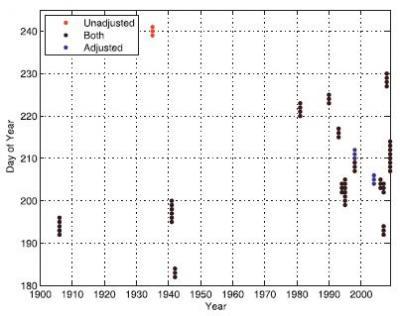Lots of people who watch the news see when records, some that have stood for a hundred years, are broken in heat waves. But the increase in minimum daily temperatures is telling a more interesting story than maximum ones. Since 1901, nighttime heat waves, when the daily low is in the top 1 percent of the temperatures on record for at least three nights in a row, have quadrupled, according to a new paper.
Researchers found that these nighttime heat waves are becoming more frequent in western Washington and Oregon. It's a good time to stay inside and read this article because, on average, heat waves tend to strike around the last week of July.
The work in the Journal of Applied Meteorology and Climatology says that the region west of the Cascades saw only three nighttime heat waves between 1901 and 1980, but that number quadrupled to 12 nighttime heat waves in the three decades after 1980. Some calibration is in order; the accuracy of temperature readings before 1980, much less back to 1901, is inconsistent.
The authors studied temperature readings west of the Cascade Mountains in Washington and Oregon from 1901 to 2009, looking for instances where the daytime high or nighttime low temperature hit the top 1 percent of readings for at least three consecutive days. The 2009 heat wave set records in daytime temperature but it was the string of warm nights that stood out. By their definition it was a three-day daytime heat wave in the Pacific Northwest – but included eight consecutive hot nights, the longest seen in the observational record.

Nighttime heat waves lasting three days or more in the Pacific Northwest between 1901 and 2009 are shown. The colors represent different ways of processing the historical readings. Credit: K. Bumbaco, UW
Why did it happen? It's well known that Pacific Northwest heat waves occur when breeze from the ocean is replaced with air flow from the east, which warms up as it flows down the western slope of the Cascade Mountains but nighttime heat waves happen during high humidity, where water vapor in the air serves as a blanket to trap heat.
Climate change numerical models project longer, more extreme and more frequent heat waves during the day and night but the paper found no significant trend in the historical record of daytime events.
The study also includes a preliminary look at health effects from heat waves, which in the U.S. account for about 1,500 deaths each year. It found a 50 percent increase in the number of regional hospitalizations coded as being related to heat on dates the authors identified as heat waves. Because the region has mild temperatures people, are not acclimatized to extreme heat and many people do not own air conditioners in their homes.




Comments